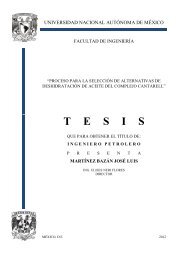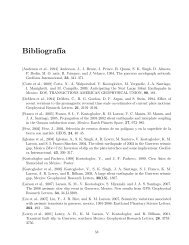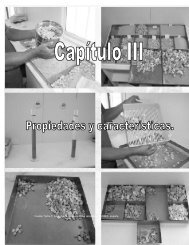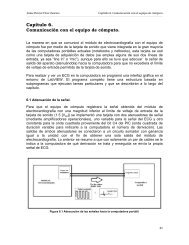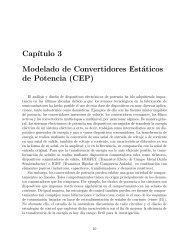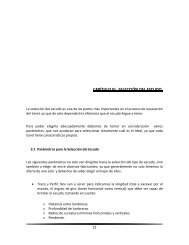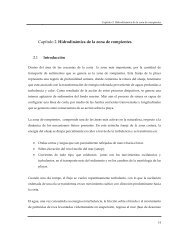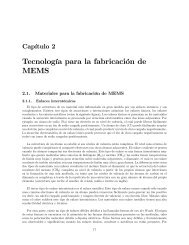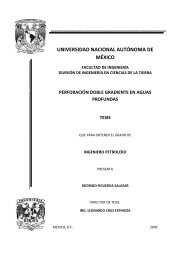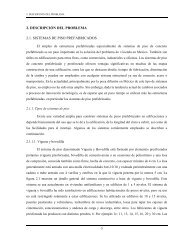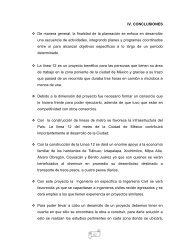u universi idad na acional l autón noma de e méxico o - UNAM
u universi idad na acional l autón noma de e méxico o - UNAM
u universi idad na acional l autón noma de e méxico o - UNAM
Create successful ePaper yourself
Turn your PDF publications into a flip-book with our unique Google optimized e-Paper software.
INDICE<br />
Introducción. i<br />
1- Antece<strong>de</strong>ntes. 1<br />
1.1. Introducción. . . . . . . . . . . . . . . . . . . . . . . . . . . . . . . . . . . . . . . . . . . . . . . . . . . . . . . . . . .2<br />
1.2. Durmientes. . . . . . . . . . . . . . . . . . . . . . . . . . . . . . . . . . . . . . . . . . . . . . . . . . . . . . . . . . . .2<br />
1.3. Materiales utilizados. . . . . . . . . . . . . . . . . . . . . . . . . . . . . . . . . . . . . . . . . . . . . . . . . . . . 4<br />
1.4. Construcción y características <strong>de</strong> los durmientes. . . . . . . . . . . . . . . . . . . . . . . . . . . . . . .5<br />
1.4.1. Durmiente <strong>de</strong> ma<strong>de</strong>ra. . . . . . . . . . . . . . . . . . . . . . . . . . . . . . . . . . . . . . . . . . . . . . . . . . 5<br />
1.4.2. Durmiente <strong>de</strong> Acero. . . . . . . . . . . . . . . . . . . . . . . . . . . . . . . . . . . . . . . . . . . . . . . . . . . 7<br />
1.4.3. Durmiente <strong>de</strong> hormigón. . . . . . . . . . . . . . . . . . . . . . . . . . . . . . . . . . . . . . . . . . . . . . . . 9<br />
1.4.4. Durmiente <strong>de</strong> polímero. . . . . . . . . . . . . . . . . . . . . . . . . . . . . . . . . . . . . . . . . . . . . . . .12<br />
1.5. Materiales compuestos para la infraestructura ferroviaria. . . . . . . . . . . . . . . . . . . . . . .13<br />
1.5.1. Origen <strong>de</strong> los durmientes compuesto <strong>de</strong> plástico para las ferrovías. . . . . . . . . . . . . .15<br />
1.5.2. Tipos <strong>de</strong> durmientes <strong>de</strong> compuesto plástico. . . . . . . . . . . . . . . . . . . . . . . . . . . . . . . . 15<br />
1.6. Antece<strong>de</strong>ntes teóricos. . . . . . . . . . . . . . . . . . . . . . . . . . . . . . . . . . . . . . . . . . . . . . . . . . .16<br />
1.6.1. Investigación comercial sobre la forma <strong>de</strong> los durmientes. . . . . . . . . . . . . . . . . . . . .16<br />
1.6.2. Acción <strong>de</strong> las cargas fijas. . . . . . . . . . . . . . . . . . . . . . . . . . . . . . . . . . . . . . . . . . . . . . 17<br />
1.6.3. El balasto. . . . . . . . . . . . . . . . . . . . . . . . . . . . . . . . . . . . . . . . . . . . . . . . . . . . . . . . . . .19<br />
1.6.4. Planteamiento <strong>de</strong>l problema <strong>de</strong> contacto. . . . . . . . . . . . . . . . . . . . . . . . . . . . . . . . . . .20<br />
1.6.5. El mo<strong>de</strong>lo <strong>de</strong> Winkler. . . . . . . . . . . . . . . . . . . . . . . . . . . . . . . . . . . . . . . . . . . . . . . . .21<br />
1.6.6. Elastic<strong>idad</strong> <strong>de</strong>l balasto. . . . . . . . . . . . . . . . . . . . . . . . . . . . . . . . . . . . . . . . . . . . . . . . .22<br />
1.6.7. Resistencia <strong>de</strong> los durmientes. . . . . . . . . . . . . . . . . . . . . . . . . . . . . . . . . . . . . . . . . . .23<br />
1.6.8. Peso <strong>de</strong> los equipos rodantes. . . . . . . . . . . . . . . . . . . . . . . . . . . . . . . . . . . . . . . . . . . .24<br />
2- Análisis elástico <strong>de</strong>l durmiente 26<br />
2.1. Introducción. . . . . . . . . . . . . . . . . . . . . . . . . . . . . . . . . . . . . . . . . . . . . . . . . . . . . . . . . .27<br />
2.2. Requerimientos y especificaciones. . . . . . . . . . . . . . . . . . . . . . . . . . . . . . . . . . . . . . . . 29<br />
2.2.1. Normas. . . . . . . . . . . . . . . . . . . . . . . . . . . . . . . . . . . . . . . . . . . . . . . . . . . . . . . . . . . . 30<br />
2.3. Mo<strong>de</strong>lo a<strong>na</strong>lítico <strong>de</strong>l durmiente. . . . . . . . . . . . . . . . . . . . . . . . . . . . . . . . . . . . . . . . . . .31<br />
2.3.1. Acción <strong>de</strong> un durmiente bajo cargas. . . . . . . . . . . . . . . . . . . . . . . . . . . . . . . . . . . . . .31<br />
2.3.2. Patrón <strong>de</strong> distribución <strong>de</strong> esfuerzos sobre un durmiente. . . . . . . . . . . . . . . . . . . . . . .32<br />
2.3.3. Desarrollo a<strong>na</strong>lítico. . . . . . . . . . . . . . . . . . . . . . . . . . . . . . . . . . . . . . . . . . . . . . . . . . .33<br />
2.4. Validación <strong>de</strong>l software. . . . . . . . . . . . . . . . . . . . . . . . . . . . . . . . . . . . . . . . . . . . . . . . . 44<br />
2.4.1. Desarrollo a<strong>na</strong>lítico <strong>de</strong> cargas uniformemente distribuidas. . . . . . . . . . . . . . . . . . . . 44<br />
2.4.2. Análisis por métodos por elemento finito para la validación <strong>de</strong>l software. . . . . . . . .53<br />
2.4.3. Comparación <strong>de</strong> resultados. . . . . . . . . . . . . . . . . . . . . . . . . . . . . . . . . . . . . . . . . . . . .60<br />
2.5. Análisis estático <strong>de</strong>l durmiente por el método <strong>de</strong> elementos finitos . . . . . . . . . . . . . . .61<br />
2.5.1. Introducción. . . . . . . . . . . . . . . . . . . . . . . . . . . . . . . . . . . . . . . . . . . . . . . . . . . . . . . . 61<br />
2.5.2. Mo<strong>de</strong>lado <strong>de</strong>l durmiente en Unigraphics NX6. . . . . . . . . . . . . . . . . . . . . . . . . . . . . .62<br />
2.5.3. Propieda<strong>de</strong>s <strong>de</strong>l material. . . . . . . . . . . . . . . . . . . . . . . . . . . . . . . . . . . . . . . . . . . . . . .63<br />
2.5.4. Mallado <strong>de</strong>l mo<strong>de</strong>lo. . . . . . . . . . . . . . . . . . . . . . . . . . . . . . . . . . . . . . . . . . . . . . . . . . .63




